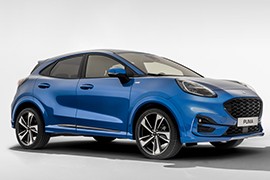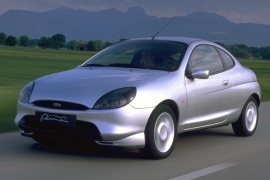FORD Puma Models/Series Timeline, Specifications & Photos
First production year: 1998
Engines: Gasoline, Mild hybrid, Diesel
Body style: SUV (Sports Utility Vehicle)
The name is old, this car is new and has high-hopes on the ever-expanding crossover market. It is meant to be loved by those who, 20 years ago, were teenagers and loved that little sport-coupe car from Ford. Except that, this time, the Puma is a crossover built in Eastern Europe after a 1.8 billion dollars investment, not a compact sports car built in Germany.
Like the old Puma, which introduced a new design language (new-edge design), the new Puma starts a new generation of Ford electrified vehicles. It features a 48-volt architecture and it is a mild-hybrid with underfloor batteries.
The new Ford Puma will have only one engine: the 1.0-liter EcoBoost with three cylinders and three power versions, starting with a 125 hp (same as the original Puma) and ending with a 155 hp version. Except for the base model, all the other trim levels will have a mild-hybrid function.
The small, 4.2m (13.7 ft) crossover Puma is able to carry 456 liters (16 cu-ft) of luggage. But don't expect something extraordinary from the available passenger space. Five people will fit inside, but not for the longest drive of your life. Those who will share the backseat are not going to be very happy after a 2-hour drive.
The new Puma also introduces the newest Ford infotainment system, SYNC 3. The system allows users to keep their phone in the wireless charging point, while they can browse or listen to music uninterrupted.
Ford introduced the Puma on the market in 1998 as a contender in the small-sized coupe segment in Europe, building the car on the same platform as the Fiesta but with significant improvements in all areas.
The American automaker gave the bio-design trend a boost when it launched the Lynx concept car at the 1996 Geneva Motor Show. Ghia designed the concept, and there were just a few people who knew that Ford considered producing it. Yet the miracle happened, and in 1998, the car manufacturer created the production version of it. The main difference between the concept and the production version was mostly the name, not the shape, which remained the same.
Ford stretched the Fiesta’s wheelbase, used Ghia to pen the vehicle, and installed a choice of gasoline engines under the car’s hood to create one of the most daring vehicles that were put on sale in Europe in the late ‘90s and the beginning of the 2000s. The car’s front sported swept-back headlights that mimicked a feline’s eyes and a half-oval-shaped upper grille where the blue-oval badge took center stage. On the lower bumper, the automaker added a broader air intake that was needed to cool the engine. Furthermore, a splitter was added underneath the apron to emphasize the car’s sporty look.
From its profile, the cab-forward design with its elliptic window line confirmed to customers that this was a real coupe, not a hatchback with slightly altered bodywork. In addition, the rear quarter panels was crossed by a crease that started from the door panels and ended on the corner-mounted taillights. The sporty little hatchback featured a rear fascia with elliptic-looking taillamps. Furthermore, the sloped rear windshield was also penned using rounded lines, like there was no straight angle or ruler in Ford’s entire design studio.
Inside, customers faced a rounded-shaped dashboard that resembled the one from the Ka and the Fiesta. Still, the instrument cluster was different and featured a center-mounted speedometer flanked on its left by the rev counter and on the right by the fuel and temperature gauges. The sports bucket seats for the front occupants featured bolstered areas to keep their occupants safe during high-speed cornering maneuvers. In the back, the tiny bench seat was mostly adequate for children due to the low roofline and limited legroom.
While some of the car’s underpinnings were shared with the Fiesta and Ka, the drivetrain was not the same. Ford offered the car fitted with a choice of three gasoline engines ranging between 90 PS (89 hp) and a peepy 125 PS (123 hp) paired with a five-speed manual gearbox. In addition, the car’s suspension and steering rack were recalibrated, making the car a better handling one compared with the regular Fiesta.

